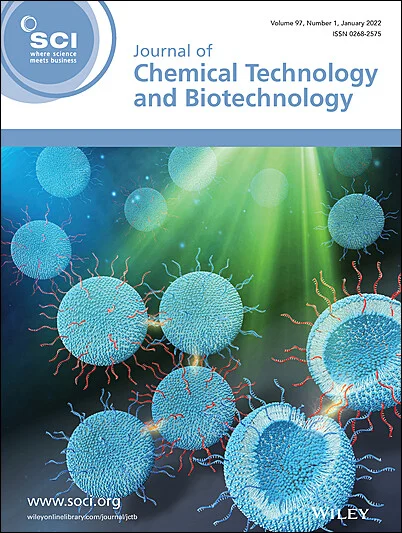Noshin Afshan, Ruba Tariq, Iqra Riaz, Abdul Manan, Azhar Iqbal, Muhammad Ejaz, Amir Sohail, Alina Bari, Sajid Mahmood, Shahid Iqbal, Khalid M Alotaibi, Matar Alshalwi
求助PDF
{"title":"具有高催化效率的抗菌框架核酸 DNA 酶簇","authors":"Noshin Afshan, Ruba Tariq, Iqra Riaz, Abdul Manan, Azhar Iqbal, Muhammad Ejaz, Amir Sohail, Alina Bari, Sajid Mahmood, Shahid Iqbal, Khalid M Alotaibi, Matar Alshalwi","doi":"10.1002/jctb.7703","DOIUrl":null,"url":null,"abstract":"<div>\n \n \n <section>\n \n <h3> BACKGROUND</h3>\n \n <p>Hydroxyl radical-mediated materials primarily liberate more reactive and acutely lethal hydroxyl radical (<sup>•</sup>OH) and act as potent bactericidal antibiotics, for example H<sub>2</sub>O<sub>2</sub>. Hydroxyl radical possess higher tendency than that of H<sub>2</sub>O<sub>2</sub> to attack various biological molecules such as DNA, proteins and iron–sulfur clusters, and impair their proper functioning, actively leading to strongly potent bactericidal effect. To acquire the desired antimicrobial effect, high concentration of H<sub>2</sub>O<sub>2</sub> is required that has found medically harmful to healthy tissues of humans.</p>\n </section>\n \n <section>\n \n <h3> RESULTS</h3>\n \n <p>We herein report framework nucleic acid-regulated DNAzyme cluster (FDC) – that is, peroxidase-like hemin-bound G-quadruplex (G4/H) DNAzyme – to amplify the catalytic reduction potential of G4/H complex, leading to high conversion rate of H<sub>2</sub>O<sub>2</sub> to more reactive hydroxyl radical that potentially shows the same antibacterial efficiency at lower and safer H<sub>2</sub>O<sub>2</sub> concentration. Specifically, we have grafted multiple copies of DNAzymes outside framework nucleic acid (FNA) to successively achieve 3–9 orders of magnitude enhancement in catalytic activity and antibacterial efficiency of FDC.</p>\n </section>\n \n <section>\n \n <h3> CONCLUSION</h3>\n \n <p>Our designed FDC has successfully alleviated H<sub>2</sub>O<sub>2</sub> toxicity and increased its efficiency as antibacterial material, as FDC amplified the catalytic reduction potential of G4/H DNAzyme, leading to high conversion rate of H<sub>2</sub>O<sub>2</sub> to more reactive <sup>•</sup>OH that potentially shows the same antibacterial efficiency at lower and safer H<sub>2</sub>O<sub>2</sub> concentration. © 2024 Society of Chemical Industry (SCI).</p>\n </section>\n </div>","PeriodicalId":15335,"journal":{"name":"Journal of chemical technology and biotechnology","volume":"99 9","pages":"2027-2034"},"PeriodicalIF":2.8000,"publicationDate":"2024-07-03","publicationTypes":"Journal Article","fieldsOfStudy":null,"isOpenAccess":false,"openAccessPdf":"","citationCount":"0","resultStr":"{\"title\":\"Antimicrobial framework nucleic acid-based DNAzyme cluster with high catalytic efficiency\",\"authors\":\"Noshin Afshan, Ruba Tariq, Iqra Riaz, Abdul Manan, Azhar Iqbal, Muhammad Ejaz, Amir Sohail, Alina Bari, Sajid Mahmood, Shahid Iqbal, Khalid M Alotaibi, Matar Alshalwi\",\"doi\":\"10.1002/jctb.7703\",\"DOIUrl\":null,\"url\":null,\"abstract\":\"<div>\\n \\n \\n <section>\\n \\n <h3> BACKGROUND</h3>\\n \\n <p>Hydroxyl radical-mediated materials primarily liberate more reactive and acutely lethal hydroxyl radical (<sup>•</sup>OH) and act as potent bactericidal antibiotics, for example H<sub>2</sub>O<sub>2</sub>. Hydroxyl radical possess higher tendency than that of H<sub>2</sub>O<sub>2</sub> to attack various biological molecules such as DNA, proteins and iron–sulfur clusters, and impair their proper functioning, actively leading to strongly potent bactericidal effect. To acquire the desired antimicrobial effect, high concentration of H<sub>2</sub>O<sub>2</sub> is required that has found medically harmful to healthy tissues of humans.</p>\\n </section>\\n \\n <section>\\n \\n <h3> RESULTS</h3>\\n \\n <p>We herein report framework nucleic acid-regulated DNAzyme cluster (FDC) – that is, peroxidase-like hemin-bound G-quadruplex (G4/H) DNAzyme – to amplify the catalytic reduction potential of G4/H complex, leading to high conversion rate of H<sub>2</sub>O<sub>2</sub> to more reactive hydroxyl radical that potentially shows the same antibacterial efficiency at lower and safer H<sub>2</sub>O<sub>2</sub> concentration. Specifically, we have grafted multiple copies of DNAzymes outside framework nucleic acid (FNA) to successively achieve 3–9 orders of magnitude enhancement in catalytic activity and antibacterial efficiency of FDC.</p>\\n </section>\\n \\n <section>\\n \\n <h3> CONCLUSION</h3>\\n \\n <p>Our designed FDC has successfully alleviated H<sub>2</sub>O<sub>2</sub> toxicity and increased its efficiency as antibacterial material, as FDC amplified the catalytic reduction potential of G4/H DNAzyme, leading to high conversion rate of H<sub>2</sub>O<sub>2</sub> to more reactive <sup>•</sup>OH that potentially shows the same antibacterial efficiency at lower and safer H<sub>2</sub>O<sub>2</sub> concentration. © 2024 Society of Chemical Industry (SCI).</p>\\n </section>\\n </div>\",\"PeriodicalId\":15335,\"journal\":{\"name\":\"Journal of chemical technology and biotechnology\",\"volume\":\"99 9\",\"pages\":\"2027-2034\"},\"PeriodicalIF\":2.8000,\"publicationDate\":\"2024-07-03\",\"publicationTypes\":\"Journal Article\",\"fieldsOfStudy\":null,\"isOpenAccess\":false,\"openAccessPdf\":\"\",\"citationCount\":\"0\",\"resultStr\":null,\"platform\":\"Semanticscholar\",\"paperid\":null,\"PeriodicalName\":\"Journal of chemical technology and biotechnology\",\"FirstCategoryId\":\"5\",\"ListUrlMain\":\"https://onlinelibrary.wiley.com/doi/10.1002/jctb.7703\",\"RegionNum\":4,\"RegionCategory\":\"生物学\",\"ArticlePicture\":[],\"TitleCN\":null,\"AbstractTextCN\":null,\"PMCID\":null,\"EPubDate\":\"\",\"PubModel\":\"\",\"JCR\":\"Q3\",\"JCRName\":\"BIOTECHNOLOGY & APPLIED MICROBIOLOGY\",\"Score\":null,\"Total\":0}","platform":"Semanticscholar","paperid":null,"PeriodicalName":"Journal of chemical technology and biotechnology","FirstCategoryId":"5","ListUrlMain":"https://onlinelibrary.wiley.com/doi/10.1002/jctb.7703","RegionNum":4,"RegionCategory":"生物学","ArticlePicture":[],"TitleCN":null,"AbstractTextCN":null,"PMCID":null,"EPubDate":"","PubModel":"","JCR":"Q3","JCRName":"BIOTECHNOLOGY & APPLIED MICROBIOLOGY","Score":null,"Total":0}
引用次数: 0
引用
批量引用

 求助内容:
求助内容: 应助结果提醒方式:
应助结果提醒方式:


